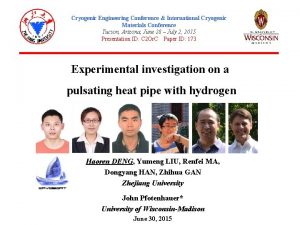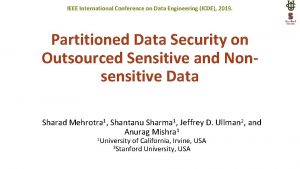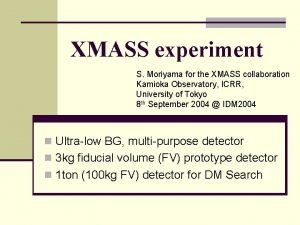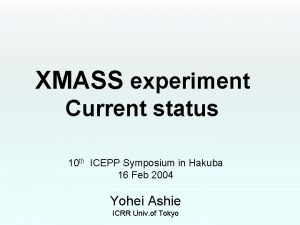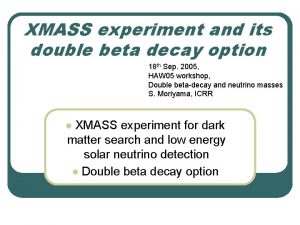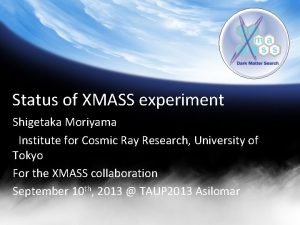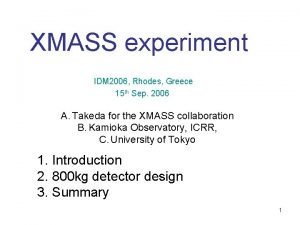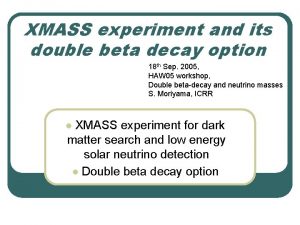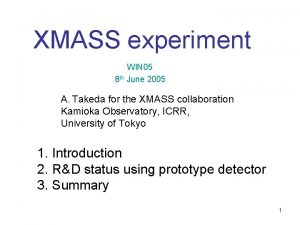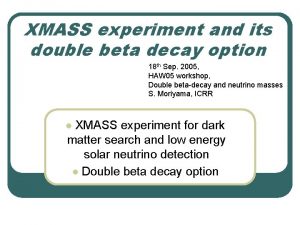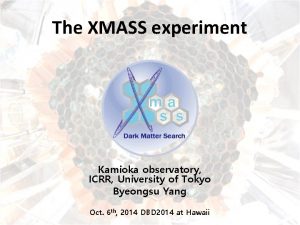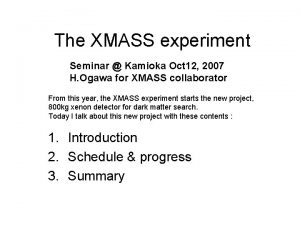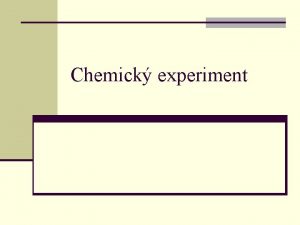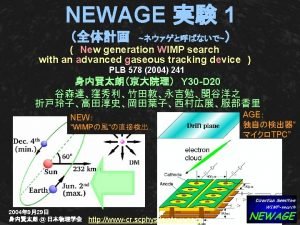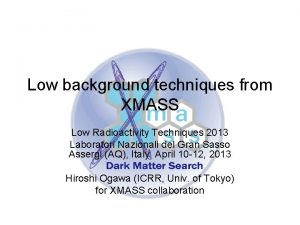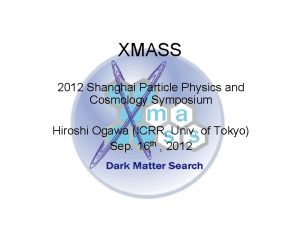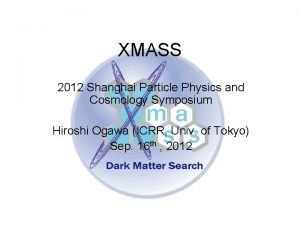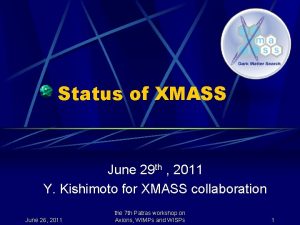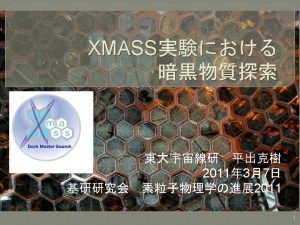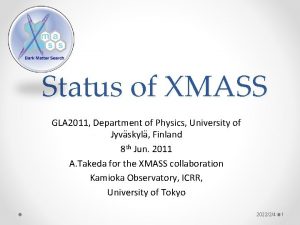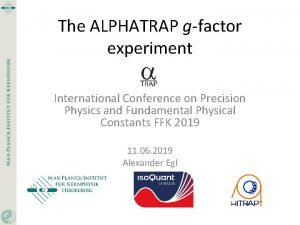XMASS experiment The 3 rd International Conference on

















![Modulation analysis XMASS Collaboration, PLB 759 (2016) 272 Rate [events/day/kg/ke. Vee] l The data Modulation analysis XMASS Collaboration, PLB 759 (2016) 272 Rate [events/day/kg/ke. Vee] l The data](https://slidetodoc.com/presentation_image_h2/7a75b229f4f20a8c553a150be0cf9434/image-18.jpg)



















- Slides: 37

XMASS experiment The 3 rd International Conference on Science, Application, and Technology of Xenon Radiation Detectors (Xe. SAT 2017) Apr. 3– 7, 2017, Pullman Raja orchid Hotel, Khon Kaen, Thailand 4 th of Apr. 2017 (14: 00– 14: 30) A. Takeda for the XMASS Collaboration 1

Experimental site Kam. LAND Kamioka Mine Super-K Japan Kamioka Mine ~1000 m underneath Mt. Ikenoyama. (2700 m. w. e. ) CANDLES XMASS(Lab-C) IPMU Labx 1 Lab 2/EGad NEWAGE CLIO Kamioka mine Lab-C 10. 5 m Tokyo Water tank XMASS I detector 10 m 2

XMASS-I detector l Inner detector l Single phase liquid xenon detector. (832 kg xenon for sensitive region) l 642 low background PMTs. (2 inch, HAMAMATSU R 10789) → each PMT signal is recorded by 10 -bit 1 GS/s waveform digitizers. l High light yield: ~15 PE/ke. V. l Outer detector l 10 m x 10. 5 m water tank with 72 PMTs (20 inch) for active muon veto Inner detector and passive radiation shield. Outer detector 10. 5 m 642 PMTs (R 10789) 832 kg liquid xenon 72 PMTs (20 inch) 3 10 m

Self-shielding of g-ray background Traces of U-chain gamma-rays from PMTs l Owing to high atomic number (Z=54), external gamma-ray background (mainly coming from PMTs) can be shielded by liquid xenon itself. l By selecting events occurred in the restricted inner volume (fiducial volume) low background can be achieved. Fiducial volume 4

History of XMASS-I 2011 2012 Dec. Construction Commissioning Run Data taking Several physics results from this term were published later Sep. 2010 2013 May Refurbishment Main BG source was identified, and it was cover with copper ring and plate. 2014 2015 2016 2017 Nov. Data taking resumed since Nov. 2013 Now, > 3 yrs continuity operation is ongoing! couts/day/ke. V/kg 2010 Commissioning run data After RFB data 6 5 4 3 2 1 0 ~1/10 4 8 12 16 Energy (scaled) [ke. V] 5 20

Inner calibration system Stepping motor l Various RI sources can be inserted inside the sensitive volume w/o interrupting detector operation. l Used for light yield monitoring, optical parameter tuning, energy and timing calibration etc. RI Energy [ke. V] diameter [mm] Geometry (1) 55 Fe 5. 9 10 2 pi source 8, 22, 25, 88 5 2 pi source (3) 241 Am 17. 8, 59. 5 0. 17 2 pi/4 pi source (4) 57 Co 59. 3(*), 122 0. 21 4 pi source (5) 137 Cs 662 5 cylindrical (2) 57 Co 109 Cd N. Y. Kim et al. , NIM A 784 (2015) 499– 503 source 19 mm 0. 21 mm Magnetic linear and rotary motion feed-through Tank top ~5 m Gate valve Water tank Source rod (Ti ) 4 mm Active region is concentrated on 1. 8 mm edge region Top PMT 6

Detector response Total number of photoelectrons data MC 59. 3 ke. V (W X-ray) 122 ke. V ~4% rms 136 ke. V l Photoelectron yield is monitored by the 57 Co source placed at the detector center. l High photoelectron yield ~ 15 pe/ke. V from 122 ke. V peak. l The distribution is reproduced by simulation well. 57 Co 4 pi source (122, 136 ke. V) X-ray from tungsten (59. 3 ke. V) used for source structure is also seen. 7

Vertex reconstruction (based on photo electron) l Position reconstruction (1) Making acceptance map: Many grid points are defined inside whole detector volume including detector surface. Events are generated at each grid point and photo-electrons (pe) expected in each PMT are calculated by our MC. (2) From measured pe and scaled acceptance map (m) in (1), position is calculated where following likelihood is maximum. Γ(x): Gamma function (Γ(n) = (n-1)!, n>0) PMTs … Reconstructed position distribution of 57 Co events (122 ke. V) z z = +40 cm z = +20 cm z = -20 cm z = -40 cm detector calibration Source position along vertical axis (z-axis) 8

Vertex reconstruction (based on timing) l Using FADC hit timing of each PMT. l Timing constant for 2– 10 ke. V events: 25± 2 ns. l Position reconstruction is done by using likelihood method from probability density function for each PMT. P(t) : probability density function xi, ti : PMT position and hit time vg : group velocity in Lxe (110 mm/ns) calibration data (5– 10 ke. V) z = 0 cm z = 20 cm z = 40 cm PMTs … Rate [/sec/cm] 241 Am z z = +40 cm z = +20 cm z = -20 cm z = -40 cm detector calibration Source position along vertical axis (z-axis) Reconstructed z [cm] → Surface events (R>40 cm) are effectively removed from this distribution. 9

Prospects for pulse shape discrimination (PSD) PSD study with a small setup l There are 2 scintillation process in liquid xenon. (1) Direct scintillation l Singlet (1 Su+): t ~ a few ns l Triplet (3 Su+): t ~ 20 ns (2) Recombination: t ~30 ns or longer 4. 6 P E/ke V . 9 20 l Singlet/triplet ratio and recombination time depend on ionization density. Electron rejection power for 50% nuclear recoil efficiency V /ke l Detail measurement of scintillation time profile for low energy e/g by XMASS-I detector has been conducted. PE l Early study of PSD with a small setup. l Electron rejection power of ~8× 10 -2 for 50% nuclear recoil efficiency at 4. 8– 7. 2 ke. Vee NIM A 659 (2011) 161 10

Scintillation time profile for low energy g induced events (1/2) H. Takiya et al. , NIM A 834 (2016) 192– 196 l 55 Fe, 241 Am, and 57 Co source (Eg = 5. 9– 122 ke. V) were used. l Waveforms are decomposed into “single PE” pulses. l Simulation (MC) takes into account optical parameters and electronics response. l By comparing of timing distribution between real data and MC, intrinsic decay time parameters are obtained. Real data MC (t 2 = 32. 0 ns, F 1 = 0. 05) MC (t 2 = 32. 0 ns, F 1 = 0. 00) Eg = 59. 5 ke. V events from 241 Am (4 pi) source. Typical raw waveform in a PMT Real data Reconstructed waveform as the sum of 1 PE pulses 3 PEs -50 0 50 Time [ns] 100 150 -20 0 20 40 60 Time [ns] 80 120 100 11

Scintillation time profile for low energy g induced events (2/2) H. Takiya et al. , NIM A 834 (2016) 192– 196 l Scintillation time is described: 50 l Energy dependence of slow decay component (t 2) was obtained as a function of mean kinetic energy of electrons induced by g-ray. l Consistent with Akimov et al. and extended them to the lower energy region to direct dark matter search. 45 t 2 [ns] l Fast decay component (t 1) is needed to reproduce our calibration data. l t 1 = 2. 2 ns (fixed) l F 1 = 0. 05– 0. 15 (increase at low energy) 40 35 30 25 1 10 103 102 1 Eelectron [ke. V] l Time profile for nuclear recoil is under study. 12

Background rate in fiducial volume including both nuclear recoil and e/g events l O(10 -4) events/day/ke. V/kg at a few 10 s ke. V region including e/g events. → widely explore various dark matter candidates as well as standard WIMPs. XMASS-I Original figure taken from D. C. Mailing, Ph. D (2014) Fig 1. 5 13

XMASS physics results Owing to low background for e/g events (not only nuclear recoil), various kinds of dark matter candidates and physics topics have been searched for. Low mass WIMPs search, PLB 719 (2013) 78 Solar axion search, PLB 724 46 (2013) Inelastic WIMP nucleus scattering search, PTEP 063 C 01 (2014) Bosonic super-WIMPs search, PRL 113, 121301 (2014) Red: XMASS (90% C. L. ) Black: DAMA LXe 2000 (90% C. L. ) Annual modulation, PLB 759 (2016) 272 Search for 2 n 2 EC on 124 Xe, 126 Xe PLB 759 (2016) 64 Expected signal with T 1/2(2 n 2 K)=4. 7 x 1021 years K-shell X-ray n n K-shell X-ray Possibility of supernova neutrino detection, Astropart. Phys. 89 (2017) 51 Supernova at 10 kpc (Livermore model) Expected signal 14 Background

Latest results: annual modulation Eur. Phys. J. C (2013) 73, JINST 2012 7 P 03009 l DAMA/LIBRA l ~250 kg Na. I(Tl) l 14 cycles → 1. 33 ton×yr l Annual modulation: 9. 2 s l No particle ID (= including electron signal) l XMASS has a larger mass of liquid xenon (832 kg), comparable exposure is accumulated in short time. l 0. 82 ton×yr from Nov. 2013 to Mar. 2015 published in PLB 759 (2016) 272 (more ~1 ton×yr data are under analysis) l No particle ID 15

Data set and event selection XMASS Collaboration, PLB 759 (2016) 272 l Data set: Nov. 2013–Mar. 2015 = 359. 2 live days (0. 82 ton×yr) Cuts to reject noises and after-pulses Cherenkov events rejection (# of hits in first 20 ns < 60% of total hits) Rejection of events occurred in front of PMT (cut by max PE/total PE) 16

Detector stability XMASS Collaboration, PLB 759 (2016) 272 l Selecting stable temperature (172. 6– 173. 0 K) and pressure (0. 162– 0. 164 MPa abs. ) periods. l PMT gain was monitored with blue LED embedded in the inner surface of detector every week. l Scintillation light yield (LY) was traced by 57 Co calibration every one or two weeks. → Intrinsic LY were extracted comparing with MC. They were stable within ± 0. 6%. → Variation of observed LY was coming from change of absorption length. This variation affects the cut efficiency which is evaluated through MC and taken into account as systematic error. Relative intrinsic scintillation LY 17
![Modulation analysis XMASS Collaboration PLB 759 2016 272 Rate eventsdaykgke Vee l The data Modulation analysis XMASS Collaboration, PLB 759 (2016) 272 Rate [events/day/kg/ke. Vee] l The data](https://slidetodoc.com/presentation_image_h2/7a75b229f4f20a8c553a150be0cf9434/image-18.jpg)
Modulation analysis XMASS Collaboration, PLB 759 (2016) 272 Rate [events/day/kg/ke. Vee] l The data set was divided into 40 time-bin (~10 days) and 0. 5 ke. Vee energy-bin. Data with statistic and systematic error 1. 05 1. 00 Expectation 7 Ge. V and 8 Ge. V WIMPs w/ 2× 10 -40 cm 2 0. 95 0. 90 0. 85 0 300 100 200 Day from 2014 Jan. 1 400 500 l Two independent fitting methods were performed. l All the time-energy bins are fitted simultaneously. Method 1: “pull term” Method 2: “covariance matrix” xx 18

Results of WIMP analysis Assuming WIMP interactions, expected rate Rex WIMP-nucleon cross section i, j is given as XMASS Collaboration, PLB 759 (2016) 272 Method 1: “pull term” Amplitude as a function of WIMP mass (mc) 90% C. L. exclusion limits on the SI WIMP-nucleon cross section by method 1 l Almost all the DAMA/LIBRA allowed region is excluded. l Difference between method 1 and 2 is within 30%. 19

Results of model independent analysis XMASS Collaboration, PLB 759 (2016) 272 Not assuming any specific dark matter model Ci , Ai : free parameters Modulation amplitude XMASS 90% C. L. positive and negative upper limits DAMA/LIBRA P-value Method 1 “pull term” Method 2 “cov. mat. ” 0. 014 (2. 5 s) 0. 068 (1. 8 s) l No significant modulated signal was observed. l 90% C. L. upper limit for amplitude (events/day/kg/ke. Vee) l 1. 1– 1. 6 ke. Vee: 2. 1(-2. 1)× 10 -2 l 2– 6 ke. Vee: (1. 7– 3. 7)× 10 -3 20

Summary l XMASS-I is a large single-phase liquid xenon detector for various dark matter candidate as well as standard WIMPs l Low background rate of (10 -4) events/day/kg/ke. V was achieved in the energy region of a few 10 s ke. V. l Detail measurement of scintillation time profile for low energy e/g has been conducted. Pulse shape discrimination is under study. l Stable and long period data-taking is on-going. l Annual modulation searches with large exposure has been conducted. Almost all the DAMA/LIBRA allowed region was excluded. 21

Backup 22

The XMASS Collaboration Kamioka Observatory, ICRR, the University of Tokyo: K. Abe, K. Hiraide, K. Ichimura, Y. Kishimoto, K. Kobayashi, M. Kobayashi, S. Moriyama, M. Nakahata, T. Norita, H. Ogawa, H. Sekiya, O. Takachio, A. Takeda, M. Yamashita and B. Yang Kavli IPMU, the University of Tokyo: J. Liu, K. Martens and Y. Suzuki Kobe University: R. Fujita, K. Hosokawa, K. Miuchi, Y. Ohnishi, N. Oka and Y. Takeuchi Tokai University: K. Nishijima 11 institutes Gifu University: S. Tasaka Yokohama National University: S. Nakamura ~40 physicists Miyagi University of Education: Y. Fukuda STEL, Nagoya University: Y. Itow, R. Kegasa, K. Kobayashi, K. Masuda and H. Takiya Sejong University: N. Y. Kim and Y. D. Kim KRISS: Y. H. Kim, M. K. Lee, K. B. Lee and J. S. Lee Tokushima University: K. Fushimi June 2014 23

Identification of BG source l Dominant BG in the commissioning run is originated from “detector surface”. l RI in PMT Al seal and on surface of PMT and PMT holder. l Such events are likely to be reconstructed inside the fiducial volume, because photons are hardly detected in neighboring PMTs. l Refurbishment from May 2012 to Nov. 2013 l PMT Al seal were covered by copper ring and plate to reduce the beta and X-ray and make a simple and flat surface. l Electro-polish is applied to those ring, plate and PMT holders. Refurbishment Red arrows: track of scintillation photons

XMASS Refurbishment Before After + Copper plate Copper ring mounting

XMASS Refurbishment work l Purpose of Refurbishment: Before installation of ring - Confirmation of BG reduction by shielding of scintillation light originated from PMT Al - Also reducing 210 Pb (2 nd largest component in BG) with electro-polishing and special clean environment. l Expected BG level: Al and surface BG are reduced to same level as PMT gamma BG. (~10 -44 cm 2 for 100 Ge. V WIMP with fiducialization) l In next step (XMASS-1. 5), it will be replaced with new PMT. Full volume Events/day/ke. V/kg w/o ring reduction After installation of ring w/ ring Energy (ke. V) 26

H. Takiya et al. , NIM A 834 (2016) 192– 196 Summary of systematic errors and obtained decay time constant 27

Annual modulation, PLB 759 (2016) 272 Two independent fitting methods Method 1: “pull term” Rdata, Rex, s(stat), s(sys) : data, expected event rate, statistical and systematic error of the (i-th energy and j-th time) bin. Ki, j : 1 s correlated systematic error based on the relative cut efficiency Method 2: “covariance matrix” xx Nbins = Ebins×tbins (total number of bins), k = i・tbins + j Vstat : statistical uncertainties of the bins Vsys : covariance matrix of the systematic uncertainties as derived from the relative cut efficiency. 28

Low mass WIMPs search PLB 719 (2013) 78 -82 l Full volume (835 kg) analysis l 6. 80 days in 2012 Feb. l 5591. 4 kg day exposure l 0. 3 ke. Vee threshold Counts/day/kg/ke. Vee 5 4 3 2 1 0 0 0. 5 1 1. 5 Energy [ke. Vee] 2 29

PLB 724 (2013) 46 -50 Solar Axion search l Axion is a hypothetical particle to solve the strong CP problem l Produced in the Sun by bremsstrahlung and Compton effect, and detected in the detector by axio-electric effect. l XMASS is suitable to search because of a large mass and low BG Bremsstrahlung and Compton effect gaee Axio-electric effect gaee ma = Our data Max allowed 50 ke. V 30

PRL 113 (2014) 121301 Bosonic super-WIMP (1/3) l Search for lighter and more weakly interacting particles is attracting attention, because • So far no evidence of SUSY particles at the LHC. • Expectation on the structure on galactic scales of the CDM scenario is richer than observed. l Bosonic super-WIMPs search (Pospelov et. al. , Phys. Rev. D 78 115012 (2008)) • A lukewarm dark matter candidate, and lighter and more weakly interacting particles than WIMPs. • Deposit energy in a target material would essentially equivalent to the super-WIMP rest mass. • Search for pseudoscalar and Photoelectric-like interaction vector boson (called as dark, para, or hidden photon) with photoelectric-like v or a interaction. • For vector boson, no experimental constraint so far. 31

PRL 113 (2014) 121301 Bosonic super-WIMP (2/3) l 166 days and 41 kg fiducial volume data. l Search for mono-energetic peak at mb (the rest mass of a bosonic super-WIMP) using various cuts optimized for each mb. ((1) pre-selection, (2) reconstructed radius (R<15 cm) cut, (3) timing cut, (4) pattern cut) l The remaining event rate of O(10 -4) /day/ke. Vee/kg is the lowest ever achieved and consistent with expected BG from 214 Pb. D. C. Malling’s thesis (2014) XMASS ↑BG level of each experiment (before separation for nuclear recoil in 2–phase DM search detector) 32

PRL 113 (2014) 121301 Bosonic super-WIMP (3/3) l Constraint on coupling constant. l For vector bosonic super-WIMPs, the first direct search in the 40– 120 ke. V range. The limit excludes the possibility Vector boson that such particles constitute all of dark matter. The most stringent direct constraint on gaee thanks to the low BG in this energy region. Pseudoscalar 33

Inelastic scattering DM search (1/2) PTEP 063 C 01 (2014) l WIMPs would cause inelastic scattering on 129 Xe. Nuclear recoil as well as 39. 6 ke. V g ray emission are expected. l Peak search at 39. 6 ke. V with various cuts are used. Signal MC for 50 Ge. V WIMP Reconstructed radius cut (R<15 cm), timing cut, (1) Pre-selection and pattern cut. Xe 129 Nuclear recoil (2) (1) & radius cut (3) (2) & timing cut (4) (3) & band cut WIMP 39. 6 ke. V gamma Observed data (165. 9 days) l c + 129 Xe* 129 Xe + g (39. 6 ke. V) l Natural abundance of 129 Xe: 26. 4% 34

PTEP 063 C 01 (2014) Inelastic scattering DM search (2/2) l 41 kg fiducial volume (129 Xe: 11 kg) w/o BG subtraction l Better limit than DAMA for > 50 Ge. V WIMPs l Another way for study on SD interaction. Red: XMASS (90% C. L. stat. only) Pink band: XMASS (w/ sys. error) Black: DAMA LXe 2000 (90% C. L. ) 50 Ge. V WIMPs an upper limit of 3. 2 pb at 90% C. L. 35

PLB 759 (2016) 64 -66 2 n double electron capture on 124 Xe (1/2) • Natural xenon contains 124 Xe (N. A. =0. 095%) which can undergo 2 n. ECEC. 124 Xe 2 - (g. s. , 0+) + 2 e- 124 Te (g. s. , 0+) + 2 ne + 2864 ke. V • In the case of 2 K-shell electrons are captured, • Only X-rays and Auger electrons are observable • Total energy deposit is 2 x EB = 63. 6 ke. V 0+ QECEC=2864 ke. V 0+ n 4. 2 d K-shell X-ray • Expected half-life is 1020 -1024 years. Xe … • 126 Xe (N. A. =0. 089%) can also undergo 2 n. ECEC, but it is much slower due to smaller Q-value (896 ke. V). n K-shell X-ray 36

PLB 759 (2016) 64 -68 2 n double electron capture on 124 Xe (2/2) -- Fiducial volume cut -- Timing cut -- Band-like pattern cut l Data set: Dec. 2010–May 2012 (132. 0 live days) l Fiducial mass of 41 kg (39 g of 124 Xe) l 5 events remained in the signal region. Expected 124 Xe 2 n 2 K-capture signal with T 1/2(2 n 2 K)=4. 7 x 1021 years 214 Pb background • 90% C. L. lower limit on 124 Xe 2 n. ECEC half-life using the Bayesian approach was set. T 1/22 n 2 K(124 Xe)>4. 7 x 1021 yrs (90%CL) 2 n 2 K 126 21 T 1/2 ( Xe)>4. 3 x 10 yrs The world best limits to date !! Published in Phys. Lett. B 759 (2016) 64 -68. 37
 International cryogenic materials conference
International cryogenic materials conference International gambling conference
International gambling conference Fassi kafyeke
Fassi kafyeke Ieee international conference on data engineering
Ieee international conference on data engineering Parvuli dei activity book
Parvuli dei activity book International space development conference
International space development conference International telemetry conference
International telemetry conference Where to find irp number on cab card
Where to find irp number on cab card Cometva
Cometva Cit international conference
Cit international conference Asbo international
Asbo international Hát kết hợp bộ gõ cơ thể
Hát kết hợp bộ gõ cơ thể Ng-html
Ng-html Bổ thể
Bổ thể Tỉ lệ cơ thể trẻ em
Tỉ lệ cơ thể trẻ em Chó sói
Chó sói Thang điểm glasgow
Thang điểm glasgow Hát lên người ơi
Hát lên người ơi Kể tên các môn thể thao
Kể tên các môn thể thao Thế nào là hệ số cao nhất
Thế nào là hệ số cao nhất Các châu lục và đại dương trên thế giới
Các châu lục và đại dương trên thế giới Công thức tính thế năng
Công thức tính thế năng Trời xanh đây là của chúng ta thể thơ
Trời xanh đây là của chúng ta thể thơ Mật thư tọa độ 5x5
Mật thư tọa độ 5x5 Phép trừ bù
Phép trừ bù độ dài liên kết
độ dài liên kết Các châu lục và đại dương trên thế giới
Các châu lục và đại dương trên thế giới Thể thơ truyền thống
Thể thơ truyền thống Quá trình desamine hóa có thể tạo ra
Quá trình desamine hóa có thể tạo ra Một số thể thơ truyền thống
Một số thể thơ truyền thống Bàn tay mà dây bẩn
Bàn tay mà dây bẩn Vẽ hình chiếu vuông góc của vật thể sau
Vẽ hình chiếu vuông góc của vật thể sau Biện pháp chống mỏi cơ
Biện pháp chống mỏi cơ đặc điểm cơ thể của người tối cổ
đặc điểm cơ thể của người tối cổ Thế nào là giọng cùng tên?
Thế nào là giọng cùng tên? Vẽ hình chiếu đứng bằng cạnh của vật thể
Vẽ hình chiếu đứng bằng cạnh của vật thể Tia chieu sa te
Tia chieu sa te Thẻ vin
Thẻ vin
